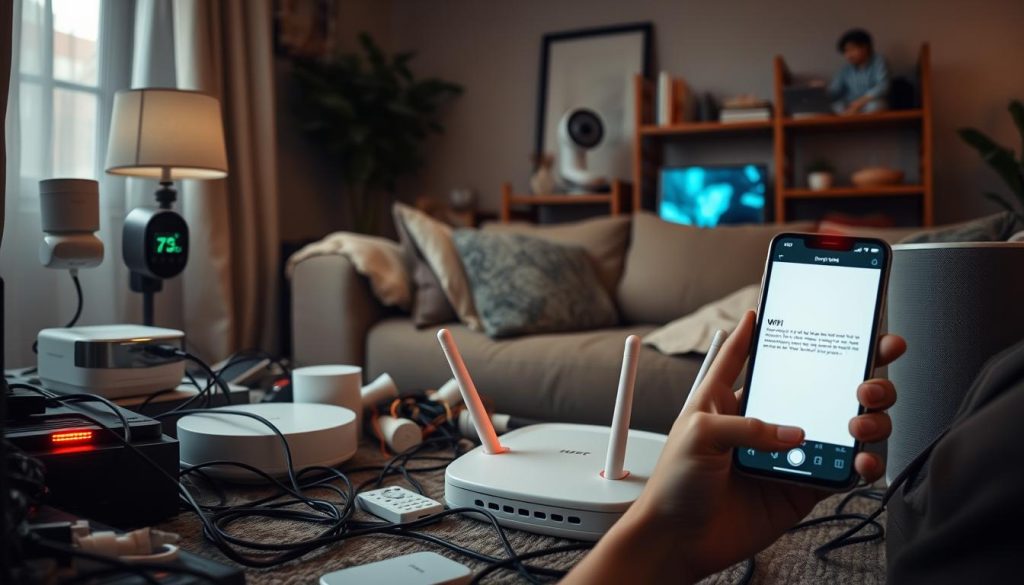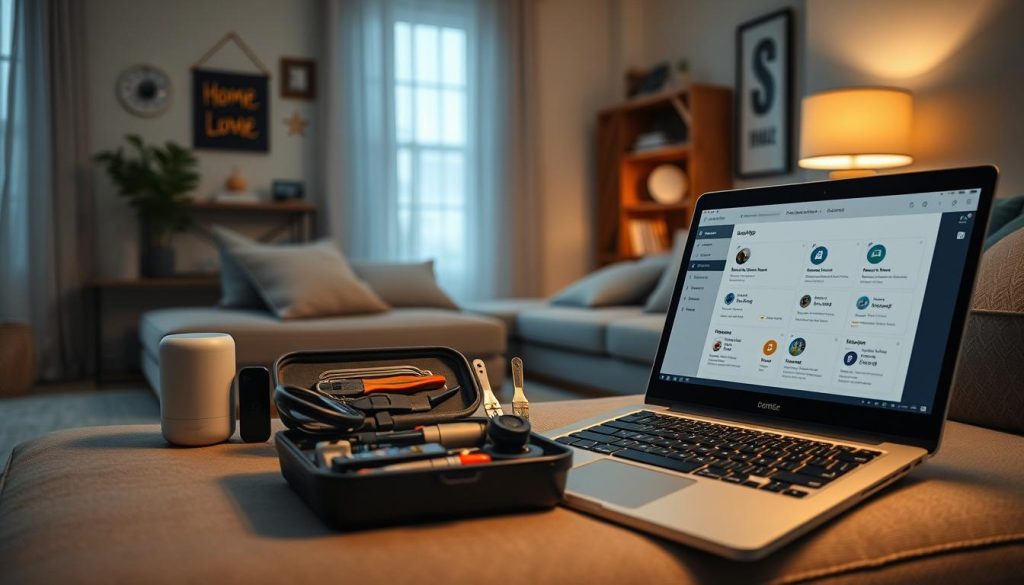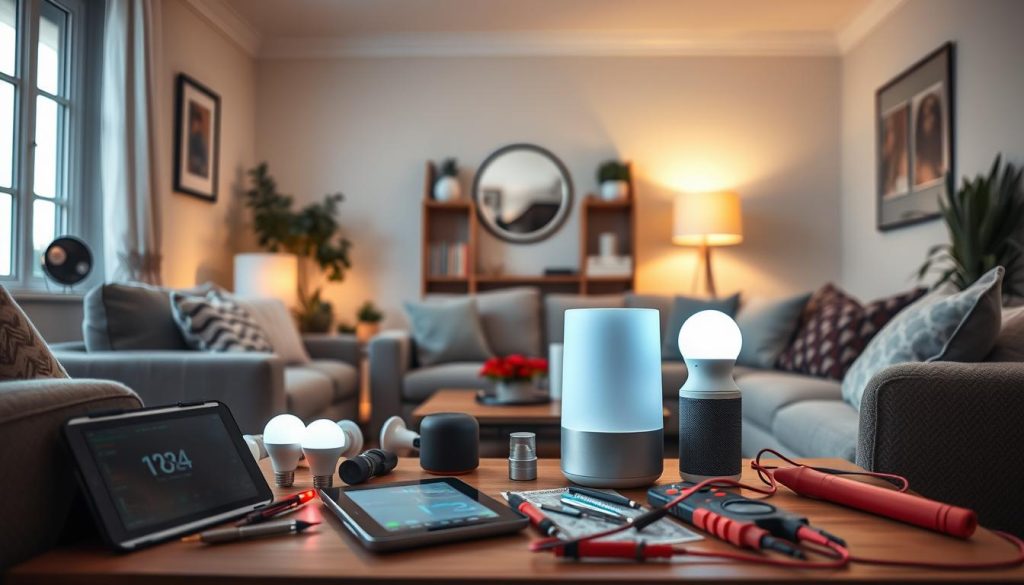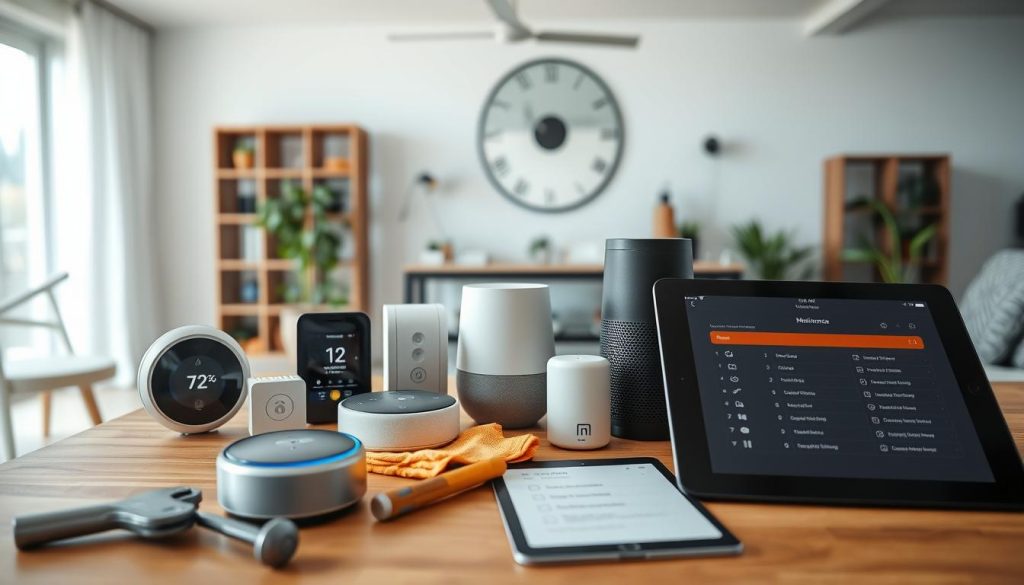I’ve faced many smart home problems as a fan. I’ve learned to quickly find and fix them. In this article, I’ll share my best tips for making smart home troubleshooting easier. This will help you solve common issues quickly.
Whether you’re new to smart homes or have been using them for a while, this article is for you. It offers useful insights and practical advice. These tips will make your smart home experience better and help you deal with any problems that come up.
Understanding the Basics of Smart Home Devices
To solve smart home problems, knowing the basics is key. A smart home has devices you can control from afar with a phone or tablet. These can be things like thermostats, lights, security cameras, and doorbells. If I see error messages, I look for the main cause.
These devices talk to each other and the internet through Wi-Fi, Bluetooth, and Zigbee. Knowing how they work helps me find and fix issues. I look at the device type, its connection, and any error messages to solve problems quickly.
What is a Smart Home?
A smart home uses technology to make life simpler and more convenient. It’s a system where devices talk to each other and to you, making everything smooth. When I run into problems, I think about the whole system and how devices work together.
Common Smart Home Devices
Some common smart home devices include:
- Thermostats
- Smart lights
- Security cameras
- Smart doorbells
How Do Smart Devices Communicate?
Smart devices use different ways to talk to each other and the internet. These include:
| Protocol | Description |
|---|---|
| Wi-Fi | A wireless networking protocol that allows devices to connect to the internet |
| Bluetooth | A wireless personal area network protocol that allows devices to communicate with each other |
| Zigbee | A low-power wireless communication protocol used for home automation |
Common Issues I Encounter with Smart Home Technology
As a smart home user, I’ve faced many issues. It’s key to know the common problems to fix them. Issues like connectivity, power, and software glitches are common. To solve these, just follow a few easy steps.
For connectivity issues, restarting devices and checking the internet helps. Here are some common problems and how to fix them:
- Connectivity problems: Restart devices and check internet connection
- Power supply issues: Check power cords and outlets
- Software glitches: Update device software and restart devices
By following these steps, I can quickly solve smart home problems. This keeps my system running well. Regular updates and maintenance also help avoid future issues.

Steps to Diagnose Smart Home Device Problems
Fixing smart home device problems can be tough, but there are steps to help. It’s key to have a plan to solve these issues quickly and well.
First, I check the internet connection. It must be strong and steady. A weak connection can lead to many problems. Then, I restart the device to see if it fixes the issue. If not, updating the device’s firmware might be needed.
Check the Internet Connection
This step is vital in fixing smart home issues. It helps find out if the problem is with the connection.
Restart the Device
Restarting the device is a basic but effective step. It can solve many problems like connectivity, power, or software issues.
Update Firmware
Updating the firmware is crucial. It fixes software problems, makes sure devices work well together, and keeps them safe from threats.
By following these steps, you can quickly find and fix common smart home problems. Always check the internet, restart the device, and update the firmware. This way, your smart home devices will work as they should.

| Step | Description |
|---|---|
| 1. Check the Internet Connection | Verify that the internet connection is stable and working properly |
| 2. Restart the Device | Restart the device to resolve connectivity, power supply, or software issues |
| 3. Update Firmware | Update the firmware to resolve software glitches, compatibility, or security vulnerabilities |
Troubleshooting Specific Device Types
Smart home devices need different fixes. Knowing this helps solve common problems. Error messages can be tricky, but understanding them saves time.
Each device works in its own way. For example, smart lights might need a check on the bulb and hub. Smart thermostats might need a look at the temperature and schedule.
Common Device-Specific Issues
- Smart lights: faulty bulbs, incorrect dimmer settings, or incompatible hubs
- Smart thermostats: incorrect temperature settings, scheduling conflicts, or sensor malfunctions
- Smart doorbells: poor video quality, motion detection issues, or connectivity problems
Knowing these issues helps fix smart home problems. It’s also key to solve error messages from devices. This ensures a smooth smart home experience.

Keeping device firmware up to date helps avoid issues. It also cuts down on error messages. This makes my smart home more efficient and convenient.
The Importance of Regular Maintenance
Keeping your smart home devices in top shape is key. Regular checks and updates are vital. This way, you can catch and fix problems early, keeping your system running smoothly.
Some important maintenance steps include:
- Cleaning up apps and devices to remove any unnecessary data or software
- Regularly updating firmware to ensure you have the latest features and security patches
These actions help avoid connectivity issues and ensure devices work well together. Staying current with updates is crucial. It makes fixing problems easier and more effective.
Regular upkeep also lets you spot issues before they become big problems. Watch for any signs of trouble and fix them quickly. This proactive approach helps keep your smart home running smoothly.

Make maintenance a priority to keep your smart home devices in great condition. This approach helps you solve problems quickly and keeps your system connected without issues.
Utilizing Customer Support and Resources
When you’re dealing with smart home issues, sometimes you need help from others. Whether it’s fixing smart devices or troubleshooting, there are many options. We’ll look at the resources that can help you solve problems fast and well.
Manufacturer Support
Start with the manufacturer’s support team. Many companies have help for their smart home devices. They offer online help, phone support, and even in-person help. By contacting the manufacturer, you can get advice from experts on fixing and troubleshooting smart devices.
Online Communities and Forums
There are also online communities and forums for smart home help. These places are great for sharing experiences and tips. You can find help on Reddit’s r/smarthome and Stack Overflow’s smart home forum.
User Manuals and Guides
Don’t forget the user manuals and guides that come with your devices. They have step-by-step instructions for troubleshooting and fixing. By following these guides, you can often solve problems yourself and avoid needing outside help.
Using these resources can make you more independent in fixing your smart home. Always follow the manufacturer’s instructions and don’t be afraid to ask for help when you need it.
Tips for Preventing Future Issues
To avoid smart home problems, take action early. This way, you can lessen the chance of error messages from your devices. It also makes fixing issues easier when they happen.
Getting your devices installed right is key. Follow the maker’s guide closely and check if all devices work well together. Knowing if devices are compatible helps avoid many problems. This prevents error messages and makes fixing things simpler.
Best Practices for Installation
- Read and follow the manufacturer’s instructions for each device
- Ensure all devices are compatible with your smart home system
- Regularly update your devices’ firmware to prevent software glitches
By following these tips, you can have a smooth smart home experience. Remember, stopping problems before they start is as important as fixing them. With the right steps, you can enjoy your smart home without the trouble of constant fixes.
Smart Home Integration Challenges
Exploring smart home devices has shown me several integration challenges. One big issue is mixing devices from different brands, leading to connectivity problems. To tackle these issues, understanding the challenges and finding solutions is key.
Integrating Different Brands
Connecting devices from various brands can be tough. Some brands use their own protocols, making it hard to link devices. But, many brands now use open standards, making integration easier. For instance, devices using Zigbee or Z-Wave can easily connect with others using the same protocol.
Managing Multiple Apps
Dealing with many apps for different devices can be overwhelming. This might cause smart home problems. To fix this, using a smart home hub is a good idea. It can connect and manage various devices and apps. Samsung SmartThings and Apple HomeKit are popular choices.
By tackling integration challenges, you can have a smooth smart home experience. With the right tools and knowledge, smart home technology can make your life easier and more convenient.
Upgrading Your Smart Home Setup
Smart home technology keeps getting better. It’s key to upgrade your setup to enjoy the newest features. This can solve problems and make fixing devices easier.
When to Consider New Devices
You might need new devices if your old ones are outdated or not compatible anymore. Upgrading can boost your smart home’s performance and efficiency. It makes troubleshooting simpler.
Benefits of Smart Hubs
Smart hubs are vital for upgrading your smart home. They help manage and control many devices smoothly. This makes fixing and troubleshooting devices more efficient.
Some smart hub benefits include:
- Centralized control and management of devices
- Improved device compatibility and integration
- Enhanced security and monitoring features
Upgrading your smart home setup makes your living space better. It’s more efficient, convenient, and enjoyable. Troubleshooting and fixing devices becomes easier too.
| Device Type | Benefits of Upgrading |
|---|---|
| Smart Thermostats | Improved energy efficiency and temperature control |
| Smart Lighting | Enhanced ambiance and energy-saving features |
| Smart Security Systems | Advanced monitoring and alert features |
Sharing My Successful Smart Home Stories
As we wrap up our smart home troubleshooting journey, I’m thrilled to share my own success stories. These tales have not only helped me solve common
smart home issues
but have also taught me a lot about using
smart home technology
to its fullest potential.
Case Study: Fixing My Smart Thermostat
My smart thermostat had a problem a few months ago. It stopped connecting to Wi-Fi. After checking the
smart home system
and internet, I found the issue. A firmware update was the culprit. A quick fix from the manufacturer’s support team fixed it, and I could control my home’s temperature again.
Lessons Learned from Smart Lighting Issues
I also had trouble with my smart lighting. The bulbs didn’t work right and were hard to set up with my wiring. But, after reading the manual, looking up online, and talking to customer support, I fixed it. Now, I can control my lights with my voice.
These stories show that with the right steps and help, you can solve any
troubleshoot smart home system
problem. I hope my experiences will help others have their own smart home success stories.


